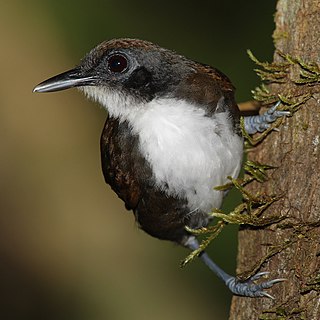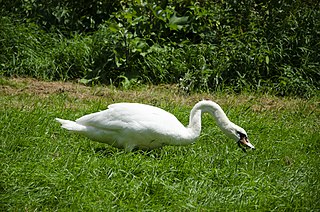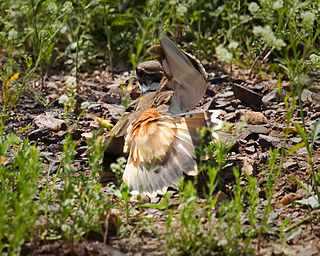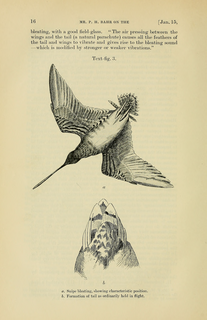 W
WAbnormal behavior of birds in captivity has been found to occur among both domesticated and wild birds. Abnormal behavior can be defined in several ways. Statistically, 'abnormal' is when the occurrence, frequency or intensity of a behaviour varies statistically significantly, either more or less, from the normal value. This means that theoretically, almost any behaviour could become 'abnormal' in an individual. Less formally, 'abnormal' includes any activity judged to be outside the normal behaviour pattern for captive birds of that particular class or age. For example, running rather than flying may be a normal behaviour and regularly observed in one species, however, in another species it might be normal but becomes 'abnormal' if it reaches a high frequency, or in another species it is rarely observed and any incidence is considered 'abnormal'. This article does not include 'one-off' behaviours performed by individual birds that might be considered abnormal for that individual, unless these are performed repeatedly by other individuals in the species and are recognised as part of the ethogram of that species.
 W
WAllofeeding is a type of food sharing behaviour observed in cooperatively breeding species of birds. Allofeeding refers to a parent, sibling or unrelated adult bird feeding altricial hatchlings, which are dependent on parental care for their survival. Allofeeding also refers to food sharing between adults of the same species. Allofeeding can occur between mates during mating rituals, courtship, egg laying or incubation, between peers of the same species, or as a form of parental care.
 W
WAnt followers are birds that feed by following swarms of army ants and take prey flushed by those ants. The best-known ant-followers are 18 species of antbird in the family Thamnophilidae, but other families of birds may follow ants, including thrushes, chats, ant-tanagers, cuckoos, motmots, and woodcreepers.
 W
WAnting is a maintenance behaviour during which birds rub insects, usually ants, on their feathers and skin. The bird may pick up the insects in its bill and rub them on the body, or the bird may lie in an area of high density of the insects and perform dust bathing-like movements. The insects secrete liquids containing chemicals such as formic acid, which can act as an insecticide, miticide, fungicide, or bactericide. Alternatively, anting could make the insects edible by removing the distasteful acid, or, possibly supplement the bird's own preen oil. Instead of ants, birds can also use millipedes. More than 200 species of bird are known to ant. A possibly related behaviour, self-anointing, is seen in many mammals.
 W
WAvian foraging refers to the range of activities and behaviours exhibited by birds in their quest for food. In addition to their unique body adaptations, birds have a range of described behaviours that differ from the foraging behaviours of other animal groups. According to the foraging habitat, birds may be grouped into foraging guilds. Foraging includes a range of activities, starting with the search for food, making use of sensory abilities, and which may involve one or more birds either of a single or even of multiple species. This is followed by locomotion and movements to obtain or capture the food, followed by the processing or handling of the foods prior to ingestion. Like all organisms foraging entails balancing the energy spent and energy gained. The high metabolic rate of birds, among the highest in the homoeotherm groups, constrains them to ensure a net positive gain in energy and have led evolutionary ethologists to develop the idea of optimal foraging.
 W
WBegging in animals is when an animal solicits being given resources by another animal. This is usually a young animal soliciting food from their parents, brood hosts or other adults. However, the resource is sometimes non-food related or may be solicited by adult animals. Begging behavior is most widely studied in birds, however, mammals, amphibians, and invertebrates perform begging displays. Generally in food solicitation, begging behavior is instinctive, although in some instances it is learned.
 W
WDistraction displays, also known as diversionary displays, or paratrepsis are anti-predator behaviors used to attract the attention of an enemy away from something, typically the nest or young, that is being protected by a parent. Distraction displays are sometimes classified more generically under "nest protection behaviors" along with aggressive displays such as mobbing. These displays have been studied most extensively in bird species, but also have been documented in populations of stickleback fish and in some mammal species.
 W
WDrumming is a sound produced by snipe as part of their courtship display flights. The sound is produced mechanically by the vibration of the outer tail feathers when flying in a downwards, swooping motion. The drumming display is usually crepuscular, though it can also be heard at any point throughout the breeding season, as well as sporadically during their migration period. Drumming is commonly heard within the context of a mating display, but it can also be displayed as means of distraction when conspecific intruders or potential predators are in the area — this can benefit male snipe in attracting a female mate. The weather can also have an impact on the acoustic properties of drumming — more humid weather will not allow the sound to carry as far and will create a deeper tone.
 W
WEgg tossing or egg destruction is a behavior observed in some species of birds where one individual removes an egg from the communal nest. This is related to infanticide, where parents kill their own or other's offspring. Egg tossing is observed in avian species, most commonly females, who are involved with cooperative breeding or brood parasitism. Among colonial non-co-nesting birds, egg-tossing is observed to be performed by an individual of the same species, and in the case of brood parasites this behavior is done by either the same or different species. The behavior of egg tossing offers its advantages and disadvantages to both the actor and recipient.
 W
WFeather-plucking, sometimes termed feather-picking, feather damaging behaviour or pterotillomania, is a maladaptive, behavioural disorder commonly seen in captive birds which chew, bite or pluck their own feathers with their beak, resulting in damage to the feathers and occasionally the skin. It is especially common among Psittaciformes, with an estimated 10% of captive parrots exhibiting the disorder. The areas of the body that are mainly pecked or plucked are the more accessible regions such as the neck, chest, flank, inner thigh and ventral wing area. Contour and down feathers are generally identified as the main target, although in some cases, tail and flight feathers are affected. Although feather-plucking shares characteristics with feather pecking commonly seen in commercial poultry, the two behaviours are currently considered to be distinct as in the latter, the birds peck at and pull out the feathers of other individuals.
 W
WBird flight is the primary mode of locomotion used by most bird species in which birds take off and fly. Flight assists birds with feeding, breeding, avoiding predators, and migrating.
 W
WGleaning is a feeding strategy by birds in which they catch invertebrate prey, mainly arthropods, by plucking them from foliage or the ground, from crevices such as rock faces and under the eaves of houses, or even, as in the case of ticks and lice, from living animals. This behavior is contrasted with hawking insects from the air or chasing after moving insects such as ants. Gleaning, in birds, does not refer to foraging for seeds or fruit.
 W
WHawking is a feeding strategy in birds involving catching flying insects in the air. The term usually refers to a technique of sallying out from a perch to snatch an insect and then returning to the same or a different perch. This technique is called "flycatching" and some birds known for it are several families of "flycatchers": Old World flycatchers, monarch flycatchers, and tyrant flycatchers. Other birds, such as swifts, swallows, and nightjars, also take insects on the wing in continuous aerial feeding. The term "hawking" comes from the similarity of this behavior to the way hawks take prey in flight, although, whereas raptors may catch prey with their feet, hawking is the behavior of catching insects in the bill. Many birds have a combined strategy of both hawking insects and gleaning them from foliage.
 W
WThe difficulty of defining or measuring intelligence in non-human animals makes the subject difficult to study scientifically in birds. In general, birds have relatively large brains compared to their head size. The visual and auditory senses are well developed in most species, though the tactile and olfactory senses are well realized only in a few groups. Birds communicate using visual signals as well as through the use of calls and song. The testing of intelligence in birds is therefore usually based on studying responses to sensory stimuli.
 W
WA kettle is a term that birders use to describe a group of birds wheeling and circling in the air. The kettle may be composed of several different species at the same time. Nature photographer M. Timothy O'Keefe theorizes that the word derives from the appearance of birds circling tightly in a thermal updraft "like something boiling in a cauldron." Ornithologist Donald Heintzelman has done more than anyone to popularize the term kettle, using the term at least as early as 1970 in his book Hawks of New Jersey to describe raptor flight, followed by uses in print over four decades. The related terms "caldron" and "boil" are also heard to describe the same sorts of raptor behavior. Osprey-watcher David Gessner, however, claims a Pennsylvania lowland called the Kettle, near Hawk Mountain, is the source of the term.
 W
WMobbing in animals is an antipredator adaptation in which individuals of prey species mob a predator by cooperatively attacking or harassing it, usually to protect their offspring. A simple definition of mobbing is an assemblage of individuals around a potentially dangerous predator. This is most frequently seen in birds, though it is also known to occur in many other animals such as the meerkat and some bovines. While mobbing has evolved independently in many species, it only tends to be present in those whose young are frequently preyed upon. This behavior may complement cryptic adaptations in the offspring themselves, such as camouflage and hiding. Mobbing calls may be used to summon nearby individuals to cooperate in the attack.
 W
WOrnithophily or bird pollination is the pollination of flowering plants by birds. This sometimes coevolutionary association is derived from insect pollination (entomophily) and is particularly well developed in some parts of the world, especially in the tropics, Southern Africa, and on some island chains. The association involves several distinctive plant adaptations forming a "pollination syndrome". The plants typically have colourful, often red, flowers with long tubular structures holding ample nectar and orientations of the stamen and stigma that ensure contact with the pollinator. Birds involved in ornithophily tend to be specialist nectarivores with brushy tongues and long bills, that are either capable of hovering flight or light enough to perch on the flower structures.
 W
WPecking is the action of a bird using their beak to search for food or otherwise investigate an object or area by tapping it. Pecking can also be used by a bird to attack or fight another bird.
 W
WPreening is a maintenance behaviour found in birds that involves the use of the beak to position feathers, interlock feather barbules that have become separated, clean plumage, and keep ectoparasites in check. Though primarily an individual function, preening can also be a social activity involving two or more birds, which is known as allopreening.
 W
WIn ethology and behavioral ecology, trap-lining or traplining is a feeding strategy in which an individual visits food sources on a regular, repeatable sequence, much as trappers check their lines of traps. Traplining is usually seen in species foraging for floral resources. This involves a specified route in which the individual traverses in the same order repeatedly to check specific plants for flowers that hold nectar, even over long distances. Trap-lining has been described in several taxa, including bees, butterflies, tamarins, bats, rats, and hummingbirds and tropical fruit-eating mammals such as opossums, capuchins and kinkajous. Traplining is used to term the method in which bumblebees and hummingbirds go about collecting nectar, and consequently, pollinating each plant they visit. The term "traplining" was originally coined by Daniel Janzen, although the concept was discussed by Charles Darwin and Nikolaas Tinbergen.
 W
WUrohidrosis is the habit in some birds of defecating onto the scaly portions of the legs as a cooling mechanism, using evaporative cooling of the fluids. Several species of storks and New World vultures exhibit this behaviour. Birds' droppings consist of feces and urine, which are excreted together through the cloaca. The term is also used to describe the analogous behaviour in seals that cool themselves while basking by urinating on their hind flippers. "Hidrosis" is the medical term for sweating from Ancient Greek, and the word "urohidrosis" was coined by M. P. Kahl in 1963:...Because of its apparent functional similarity to true sweating, I suggest the term urohidrosis for this phenomenon.
 W
WThe whistling warbler is a species of bird in the New World warbler family. It is monotypic within the genus Catharopeza. It has a dark back that fades into a lighter gradient going towards the chest. It also has a dark head,a dark strip on the breast, and a light orbital. Both male and female have the same plumage. It is endemic to the island of Saint Vincent in the Lesser Antilles. Its natural habitats are subtropical or tropical moist lowland forest and subtropical or tropical moist montane forest. It is threatened by habitat loss. This habitat loss is due to volcanic activity and deforestation. Whistling warblers have cup-shaped nests, and spotted eggs. Their diet primarily consists of insects.